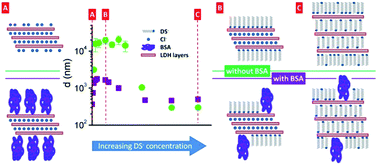Size-tunable LDH–protein hybrids toward the optimization of drug nanocarriers†
Abstract
Layered double hydroxides (LDHs) are extensively investigated as drug nanocarriers due to their anion exchange properties and potential capacity to achieve enhanced cellular trafficking and targeted delivery. In this work, LDH–protein hybrids with controlled particle size were obtained by modulation of the charge and hydrophobicity of LDH matrixes. In order to do that, bovine serum albumin (BSA) adsorption was studied in LDH matrixes intercalated with chloride and dodecylsulfate (DS−) in different ratios and its dependence on pH and ionic strength was determined. Positively charged LDH-Cl matrixes in aqueous solution changed from micro- to nano-size when adsorbing BSA molecules at pH values higher than the isoelectric point of the protein. On the other hand, the low BSA hybridization with a negatively charged LDH-DS matrix was not enough to reduce its particle size. However, a fine tuning of the physicochemical properties of the LDH-Cl matrix by controlled DS− incorporation and pH and ionic strength conditions allowed LDH–BSA nanohybrids to be partially intercalated with the surfactant that exhibited colloidal stability at high ionic strength (similar to that of biological fluids).


 Please wait while we load your content...
Please wait while we load your content...